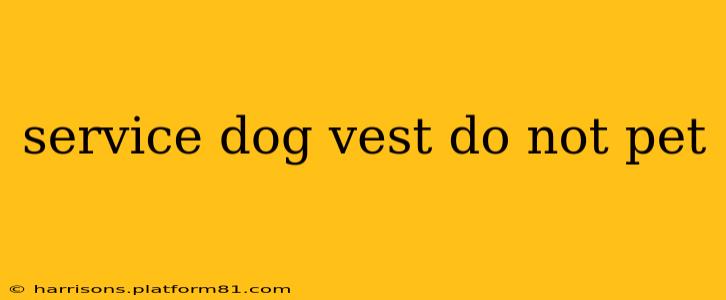Service dogs play a vital role in the lives of many individuals, providing crucial assistance and support. Their vests, often emblazoned with the phrase "Do Not Pet," are more than just clothing; they're a clear and crucial communication tool signifying the dog's working status. Understanding and respecting this is paramount to ensuring these incredible animals can perform their duties effectively and safely. This guide explores why it's so important to heed the "Do Not Pet" message and what you can do to support service dog handlers.
Why Is It Important to Respect the "Do Not Pet" Message on a Service Dog Vest?
The simple phrase "Do Not Pet" on a service dog vest carries significant weight. Distracting a service dog, even with seemingly harmless petting, can have serious consequences for both the dog and its handler.
-
Interruption of Focus: Service dogs are highly trained to concentrate on their handler's needs. A seemingly innocent interaction can break their concentration, disrupting their crucial task and potentially leading to an accident or compromising the handler's safety. Imagine a guide dog leading a visually impaired person across a busy street – a distraction could be catastrophic.
-
Safety Concerns: Some service dogs are trained to perform tasks that require a high degree of focus and precision. A sudden interruption might cause the dog to react unpredictably, potentially endangering both itself and the people around it.
-
Health and Hygiene: While most service dogs are well-groomed, petting could expose them to allergens or illnesses, potentially affecting their health and ability to work. Their handlers often have underlying health conditions, and this is another important reason to avoid contact.
-
Legal Protections: The Americans with Disabilities Act (ADA) protects individuals with disabilities and their service animals. Ignoring the "Do Not Pet" request is a violation of these protections and can have legal ramifications.
What if a Service Dog Seems Friendly and Approachable?
Even if a service dog appears friendly and eager for attention, it's vital to resist the urge to pet it. The dog's calm demeanor is a result of rigorous training, not an invitation to interact. Ignoring the "Do Not Pet" signal shows a lack of respect for both the dog and its handler.
How Can I Support Service Dog Handlers?
There are many ways to show support for service dog handlers without interacting directly with their dogs:
- Respect their space: Give them a wide berth and avoid making eye contact or attempting to talk to them. Let them pass freely without obstructing their way.
- Offer assistance if needed (but always ask first): If you feel they need help with something, politely offer assistance before acting. Don’t assume they require your aid.
- Educate yourself and others: Spread awareness about service dogs and their importance by sharing information with friends and family.
- Never ask intrusive questions: It's inappropriate to ask about the handler's disability or the dog's specific tasks. Respect their privacy.
What if my Child Wants to Pet a Service Dog?
Children are naturally curious and often drawn to animals. It's crucial to teach them early on about the importance of respecting service dogs and their handlers. Explain why it's inappropriate to pet a dog wearing a service vest. Positive reinforcement and modeling appropriate behavior are crucial.
What Does a Service Dog Vest Look Like?
Service dog vests come in a variety of styles, colors, and materials, but they often feature visible identification, such as the words "Service Dog" or "Do Not Pet." Some vests may also include patches or logos indicating the dog's training or organization. The key is the presence of clear identification marking the dog as a working animal.
This guide emphasizes the crucial need for respecting service dogs and their handlers. By understanding the importance of the "Do Not Pet" message, we can create a more inclusive and supportive environment for individuals relying on their service animals. Remember, a moment of restraint can make a world of difference.
